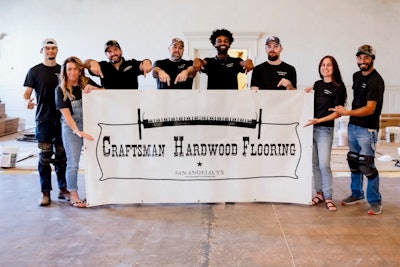
The vast majority of craftsmen who scale up for growth don’t see the profits needed to justify their venture and end up burned out, ultimately downsizing to regain their time and passion for the trade. This age-old conundrum has been called the “tradesman’s curse”—and for legitimate reasons.
So many wood flooring businesses are born from the love of the craftsmanship. That’s how I started. I knew how to be efficient with my time and produce amazing quality, either working solo or having an apprentice by my side, and I had a great career as a self-employed subcontractor. I had a family of flooring installers and finishers I could call on to team up for large projects. Life was good.
I had a dream of selling all my own products: prefinished and unfinished wood flooring of all types. I love custom floors, so this gave me an opportunity to produce custom borders, inlays, and parquet, and create award-winning floors. I wanted to promote that with my love and passion for the craft.
I made a life-changing move from California to Texas eight years ago and decided to build the company I always wanted. The reality was that I would need a showroom and warehouse, office and sales staff, several crews of field technicians, legal and professional services, and the list goes on.
We got the warehouse, and then showroom space became available in our building, so we got that going, we hired a sales person, and then, of course, we needed to hire more crews! We did not have systems and processes to run all these facets of the business, and it was overwhelming, to say the least. The profits did not justify the work and liabilities.
RELATED: How We Modernized Our Business as the Next Generation
We are so much more than what we create as a company. Everyone in the company has hopes, dreams, and passions, and I was not going to throw the baby out with the bath water. I was determined to learn how to create business management systems so that we could succeed as a company and individually!
I read all the major business books and listened to many podcasts. I read books like “The E-Myth” and “Profit First for Contractors,” so I had a lot of knowledge rattling around in my brain, but how would that translate in a way I could implement? I joined a mastermind group for flooring businesses from Floor Academy. It was eye-opening seeing business owners with much larger companies working out their systems and processes. The big takeaway was to create a solid business management operating system from the beginning, because it is much easier to course-correct a small ship than a big one. I loved this analogy—it is a great tangible concept. We set quarterly goals and worked on systems and processes, and now we meet every other week for accountability and feedback.
I also hired a CFO coach; his company also keeps our books and does our taxes. It’s amazing to have a coach open your books and analyze your business from a purely financial perspective. It’s a very freeing experience to let go of pride, get vulnerable and take advice from someone outside the flooring industry. He gave us homework for improvement each month, and then we would check in for feedback. He wanted to get us away from being reactive and be more proactive. We built a cash flow projection spreadsheet where we can budget all our payroll and costs, then we add in all deposit and final payment information based on our scheduled completion dates. The spreadsheet has a running balance so we can budget the whole year based on fixed costs and previous year averages, then fill in variable information as we go so we can see what months are strong or need improvement.
One of the biggest hurdles I see with business growth is the lack of documented systems and processes, from the sales and office staff to the field technicians. When everyone has their own system in a company, there is so much room for inefficiency, miscommunication, and ultimately chaos without accountability. Where do you even start creating a cohesive operating system that is fully integrated into the structure of your company? When a company is growing, individuals in the company may wear many hats, for example, the salesperson might also be the secretary—who also runs payroll. Or the the owner runs HR, is the trainer, dispatcher, warehouse person, and so on and so on! The field technicians on crews need accountability, guidance and training. They need to understand what brings value to the company. In many cases the field technicians don’t have defined quality, productivity, and efficiency standards—and then we wonder why employee retention can be such a challenge!
This may sound overwhelming, but there is a clear path forward! Here’s how I broke it down for my business.
Workflow: The easiest way for me to think about how the operating system of my business should work is the natural progression of the workflow. We start with how we get the lead, we sell products and services to the client, we procure the products and provide the services, we finalize the project and collect final payment. We document the most efficient system for each stage that is cohesive for the next stage and create a digital information retrieval system to reduce bottlenecks and provide accountability. A good customer relationship management system (CRM) will help the process.
RELATED: How We Improve Efficiency and Avoid Mistakes By Using a Photo App
Project analysis: The next thing we do is create a data set for project costing, everything from commissions, wages, bonuses, and profitability numbers broken down into product and services, etc. We do this with software/apps and spreadsheets we built for our company to get all the key information we need to consistently check the pulse of the company.
Quality standards: The culture of the company is highly dependent on the value for quality. If too much emphasis is placed on production, quality will suffer. We evaluate and reward for efficiency while maintaining quality standards. A solid training program will support the quality standards and efficiency.
KPIs: We pull from the data set on our spreadsheet all the key performance indicators (KPIs) to give us tangible ways to evaluate how we create the best success for the company such as average ticket price and conversion rate for sales. For our service offerings, we can analyze time spent and production costs to dial in the most profitable services we offer and what services we need to charge more for or stop offering.
Scorecards: Every employee should have a scorecard; this scorecard is developed from the KPIs and quality standards analysis. The KPIs tell us what brings the most value from the employees to the company. Included are the quality standard analysis and praise or complaints from clients and colleagues. The employees can gauge their performance, and the company can appropriately reward their success. We can provide a development plan for them where they need improvement, giving them a clear path for success.
Performance pay structure: This can be a combination of hourly, piecework, commission and bonus. It is developed from the KPIs and scorecards to incentivize, reward, and motivate employees to hit their full potential so they can bring the most value to the company through efficiency and quality. We use a spreadsheet to calculate these factors and reward each employee fairly without compromising the company’s profitability. The training program can support the performance pay structure so the employees have a clear path for success. We rank employees as Apprentice 1, Apprentice 2, Journeyman, and Master Craftsman. As they level up on their career path and produce quality, they can achieve higher hourly pay and get a larger portion of the bonuses.
Cash flow projection: Business budgeting and cash flow can make or break a business. Use software/apps and/or a spreadsheet to budget out as much into the future as necessary. You’ll know when to buy inventory, invest into new equipment, pay owner’s equity, draws, etc., with the optimal timing as you navigate the growth of your business.
You’re probably thinking, this sounds great—but it sounds like a lot of work! Well, building a strong business is a lot of work and definitely not for the faint of heart. You can make a difference for the people around you. The goal of this article is to help reduce the work and get to great solutions quicker. We will dive further into each one of these business operations as a series on woodfloorbusiness.com, so stay tuned as we break down these topics in further detail to help you hit your goals out of the park.
Editor's Note:
Be sure to read all of Matt's blog posts in this series:
Breaking the “Tradesman’s Curse” for Growth, Part 1: Creating Your Standard Operating Procedures
Breaking the 'Tradesman’s Curse' for Growth, Part 2: Project Analysis
Breaking the 'Tradesman’s Curse' for Growth, Part 3: Setting Quality Standards
Breaking the 'Tradesman’s Curse' for Growth, Part 4: Key Performance Indicators
Breaking the 'Tradesman’s Curse' for Growth, Part 5: Employee Scorecards
Breaking the 'Tradesman’s Curse' for Growth, Part 6: Performance Pay
Breaking the 'Tradesman’s Curse' for Growth, Part 7: The Power of Cash Flow
See author Matt Garcia discuss this here:

































